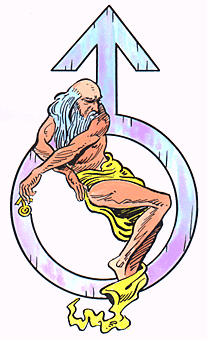Uranus, words from myths
(Uranus with Seventeen Sattelites; seventh planet from the sun)
Uranus, father of Saturn and grandfather of Jupiter

Uranus is the ancient Greek deity of the Heavens, the earliest supreme god

Astrological Sign
- Uranus was the son and mate of Gaia, the father of Cronus (Saturn) and of the Cyclopes, and of the Titans (predecessors of the Olympian gods).
- Careful pronunciation may be necessary to avoid embarrassment. Say: YOOR uh nuhs or yoo RAY nuhs.
- Pluto was the god of the lower world in Greek mythology whose name meant riches or wealth.
- Uranus, the first planet discovered in modern times, was discovered by William Herschel while systematically searching the sky with his telescope on March 13, 1781.
- It had actually been seen many times before but ignored as simply another star (the earliest recorded sighting was in 1690 when John Flamsteed cataloged it as 34 Tauri).
- Herschel named it “the Georgium Sidus” (the Georgian Planet) in honor of his patron, the infamous (to Americans) King George III of England; others called it “Herschel”.
- The name Uranus was first proposed by Johann Elert Bode (1747-1826, German astronomer) in conformity with the other planetary names from classical mythology but it didn't come into common use until 1850.
- Herschel developed and improved a reflecting telescope and used it to discover the planet Uranus (March 13, 1781) and the moons of Uranus and of Saturn.
- Uranus is the third of the Gas Giant planets, and the first planet discovered in “modern” times (1781).
- It is barely visible from the Earth without a telescope, which explains why it was not known as a planet to the ancients, and why it had been observed various times after the telescope had been invented without the observers realizing that it was a planet and not a star.
- Uranus has five large moons: Miranda, Ariel, Umbriel, Titania, and Oberon.
- There are ten small satellites and at least nine rings.
- As with most of the planets, Uranus, too, has a very unique feature.
- It is the only planet that does not rotate perpendicularly to the ecliptic plane.
- This is to say that Uranus lies on its side, or tipped over, and its north pole points almost directly toward the sun for a half Uranian year, and its south pole points toward the Sun during the other half.
- This strange axis tilt produces some extreme seasonal effects.
- No one knows why Uranus is tilted in this way.
- Some have speculated that another planet-sized body might have altered the planet’s spin axis, but there is no direct evidence for such an occurrence.
- Until the Voyager made its probe in space Uranus was known to have five moons.
- These moons are Miranda, Oberon, Titania, Umbriel and Ariel; but, ten small new moons were discovered within the orbit of Miranda.
- Uranus moons were named from Shakespeare plays and a poem written by Alexander Pope.
- All five are approximately 50% denser than water showing that some type of ice is present.
- This ice is believed to be either methane, ammonia, frozen water, or other types of compounds.
- All of the moons are dark gray in color which leads scientists to believe they could be covered with carbon soot or graphite.
A few scientific facts about Uranus:
New rings discovered going around Uranus
The Space Telescope Science Institute reported on December 22, 2005, to the surprise of astronomers, that NASA's Hubble Space Telescope has photographed a pair of new rings around the distant planet Uranus.
The largest is twice the diameter of the planet's previously known rings. The new rings are so far away that they are being called Uranus's "second ring system".
In addition, Hubble has spied two small satellites, one sharing its orbit with one of the newly discovered rings.
Even more surprisingly, precise analysis of the data reveals that the orbits of Uranus's family of inner moons have changed significantly in the last decade.
Collectively, these new discoveries mean that Uranus has a densely packed, rapidly changing, and possibly unstable dynamical system of orbiting bodies.
"The new discoveries dramatically demonstrate that Uranus has a youthful and dynamic system of rings and moons," says Mark Showalter of the SETI Institute. "Until now nobody had a clue the rings were there, we had no right to expect them."
 The page of planet images.
The page of planet images.
